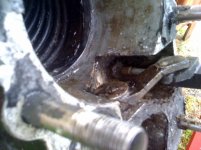20miler
Contributing Member
Hello again guys,
Well, I replaced my lower shift cable and went to the mercury parts certidfied guy and asked for a kit for a prealpha drive. He gave me something that required redrilling and tapping so that the cable mount INSIDE the stern drive end is mounted in the reverse manner of the old. So when I assembled it, it was quite smooth to shift EXCEPT it "hitches" if I try reverse on that darned brass sleeve- thus I cannot shift into reverse unless I really crank on it. So in summary the plastic shifting end piece is NOT clearing the brass sleeve on the end of the cable, nor sliding up over it smoothly enough to do without the engine stalling. What should I do? Is this deisign for real? I almost couldn't believe that it was designed like this. That it could possibly encounter this problem. Is there a way to adjust this that I simply missed?
Well, I replaced my lower shift cable and went to the mercury parts certidfied guy and asked for a kit for a prealpha drive. He gave me something that required redrilling and tapping so that the cable mount INSIDE the stern drive end is mounted in the reverse manner of the old. So when I assembled it, it was quite smooth to shift EXCEPT it "hitches" if I try reverse on that darned brass sleeve- thus I cannot shift into reverse unless I really crank on it. So in summary the plastic shifting end piece is NOT clearing the brass sleeve on the end of the cable, nor sliding up over it smoothly enough to do without the engine stalling. What should I do? Is this deisign for real? I almost couldn't believe that it was designed like this. That it could possibly encounter this problem. Is there a way to adjust this that I simply missed?




